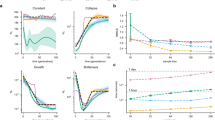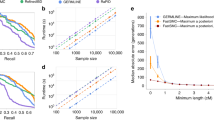Abstract
With genotyping of high-density single nucleotide polymorphisms (SNPs) replacing that of microsatellite markers in linkage studies, it becomes possible to accurately determine the genomic regions shared identity by descent (IBD) by family members. In addition to evaluating the likelihood of linkage for a region with the underlining disease (the LOD score approach), an appropriate question to ask is what would be the expected number and sizes of IBD regions among the affecteds, as there could be more than one region reaching the maximum achievable LOD score for a given family. Here, we introduce a computer program to allow the prediction of the total number of IBD regions among family members and their sizes. Reversely, it can be used to predict the portion of the genome that can be excluded from consideration according to the family size and user-defined inheritance mode and penetrance. Such information has implications on the feasibility of conducting linkage analysis on a given family of certain size and structure or on a few small families when interfamily homogeneity can be assumed. It can also help determine the most relevant members to be genotyped for such a study. Simulation results showed that the IBD regions containing true mutations are usually larger than regions IBD due to random chance. We have made use of this feature in our program to allow evaluation of the identified IBD regions based on Bayesian probability calculation and simulation results.
Similar content being viewed by others
Log in or create a free account to read this content
Gain free access to this article, as well as selected content from this journal and more on nature.com
or
References
Goddard KA, Wijsman EM : Characteristics of genetic markers and maps for cost-effective genome screens using diallelic markers. Genet Epidemiol 2002; 22: 205–220.
Evans DM, Cardon LR : Guidelines for genotyping in genomewide linkage studies: single-nucleotide-polymorphism maps versus microsatellite maps. Am J Hum Genet 2004; 75: 687–692.
John S, Shephard N, Liu G et al: Whole-genome scan, in a complex disease, using 11 245 single-nucleotide polymorphisms: comparison with microsatellites. Am J Hum Genet 2004; 75: 54–64.
Carlson CS, Eberle MA, Rieder MJ, Smith JD, Kruglyak L, Nickerson DA : Additional SNPs and linkage-disequilibrium analyses are necessary for whole-genome association studies in humans. Nat Genet 2003; 33: 518–521.
Kruglyak L : The use of a genetic map of biallelic markers in linkage studies. Nat Genet 1997; 17: 21–24.
Sawcer SJ, Maranian M, Singlehurst S et al: Enhancing linkage analysis of complex disorders: an evaluation of high-density genotyping. Hum Mol Genet 2004; 13: 1943–1949.
Lin G, Wang Z, Wang L, Lau YL, Yang W : Identification of linked regions using high-density SNP genotype data in linkage analysis. Bioinformatics 2008; 24: 86–93.
Donnelly KP : The probability that related individuals share some section of genome identical by descent. Theor Popul Biol 1983; 23: 34–63.
Risch N : Linkage strategies for genetically complex traits. II. The power of affected relative pairs. Am J Hum Genet 1990; 46: 229–241.
Thompson E, Basu S : Genome sharing in large pedigrees: multiple imputation of ibd for linkage detection. Hum Hered 2003; 56: 119–125.
Gschwend M, Levran O, Kruglyak L et al: A locus for Fanconi anemia on 16q determined by homozygosity mapping. Am J Hum Genet 1996; 59: 377–384.
Lander ES, Botstein D : Homozygosity mapping: a way to map human recessive traits with the DNA of inbred children. Science 1987; 236: 1567–1570.
Mueller RF, Bishop DT : Autozygosity mapping, complex consanguinity, and autosomal recessive disorders. J Med Genet 1993; 30: 798–799.
Zhao H, Speed TP : On genetic map functions. Genetics 1996; 142: 1369–1377.
Broman KW, Weber JL : Characterization of human crossover interference. Am J Hum Genet 2000; 66: 1911–1926.
Zhao H, Speed TP, McPeek MS : Statistical analysis of crossover interference using the chi-square model. Genetics 1995; 139: 1045–1056.
Woods CG, Valente EM, Bond J, Roberts E : A new method for autozygosity mapping using single nucleotide polymorphisms (SNPs) and EXCLUDEAR. J Med Genet 2004; 41: e101.
Purcell S, Neale B, Todd-Brown K et al: PLINK: a tool set for whole-genome association and population-based linkage analyses. Am J Hum Genet 2007; 81: 559–575.
Stoy J, Edghill EL, Flanagan SE et al: Insulin gene mutations as a cause of permanent neonatal diabetes. Proc Natl Acad Sci USA 2007; 104: 15040–15044.
Berkovic SF, Dibbens LM, Oshlack A et al: Array-based gene discovery with three unrelated subjects shows SCARB2/LIMP-2 deficiency causes myoclonus epilepsy and glomerulosclerosis. Am J Hum Genet 2008; 82: 673–684.
Daiger SP, Bowne SJ, Sullivan LS : Perspective on genes and mutations causing retinitis pigmentosa. Arch Ophthalmol 2007; 125: 151–158.
Hartong DT, Berson EL, Dryja TP : Retinitis pigmentosa. Lancet 2006; 368: 1795–1809.
Woods CG, Cox J, Springell K et al: Quantification of homozygosity in consanguineous individuals with autosomal recessive disease. Am J Hum Genet 2006; 78: 889–896.
White DR, Ganesh A, Nishimura D et al: Autozygosity mapping of Bardet-Biedl syndrome to 12q21.2 and confirmation of FLJ23560 as BBS10. Eur J Hum Genet 2007; 15: 173–178.
Acknowledgements
WY thanks the support from the University Research Committee and LKS Faculty of Medicine, University of Hong Kong. LW's research is supported by the Research Grants Council of Hong Kong SAR, China (Project No. CityU 121207).
Author information
Authors and Affiliations
Corresponding authors
Rights and permissions
About this article
Cite this article
Yang, W., Wang, Z., Wang, L. et al. Predicting the number and sizes of IBD regions among family members and evaluating the family size requirement for linkage studies. Eur J Hum Genet 16, 1535–1543 (2008). https://doi.org/10.1038/ejhg.2008.116
Received:
Revised:
Accepted:
Published:
Issue date:
DOI: https://doi.org/10.1038/ejhg.2008.116
Keywords
This article is cited by
-
HaploShare: identification of extended haplotypes shared by cases and evaluation against controls
Genome Biology (2015)
-
A homozygous 237-kb deletion at 1p31 identified as the locus for midline cleft of the upper and lower lip in a consanguineous family
European Journal of Human Genetics (2014)
-
Identifying mutation regions for closely related individuals without a known pedigree
BMC Bioinformatics (2012)
-
Linked region detection using high-density SNP genotype data via the minimum recombinant model of pedigree haplotype inference
BMC Bioinformatics (2009)



